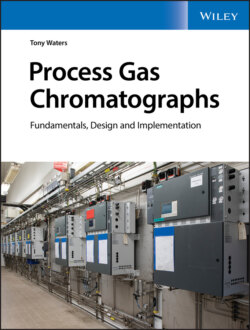Читать книгу Process Gas Chromatographs - Tony Waters - Страница 46
The effect of movement
ОглавлениеSo far, the discussion about equilibrium cannot explain chromatography. There is something missing from Figure 2.3, something that is essential for chromatography to occur. Figure 2.3 starts to explain what happens in a column, but it's not enough.
What is missing?
The gas phase is not moving! Recall that chromatography occurs when something moves across something that doesn't move. And in a gas chromatograph, it's the carrier gas that moves.
When the carrier gas moves, any propane molecules that happen to be in the gas phase are carried along with it, as illustrated in Figure 2.4a. In this figure, fresh carrier gas enters from the left and pushes the propane molecules out to the right replacing them with pure helium. In Figure 2.4b, the 50 % propane molecules are gone from the gas phase, and the other 50 % are stuck in the liquid phase. Pure helium now occupies the gas space, upsetting the original equilibrium.
Figure 2.4 The Carrier Gas Moves.
Let's see what happens next. Imagine the small enclosed space is again sealed. The absence of propane molecules in the gas phase doesn't affect the behavior of the molecules trapped in the liquid. They continue to escape from the liquid into the clean helium above, as they did before. See Figure 2.4b. It should come as no surprise that as soon as some of the molecules reenter the gas phase, they start to dissolve in the liquid again, quickly forming the new equilibrium in Figure 2.4c.
Of course, it doesn't stop there. When the carrier gas again moves it disrupts the equilibrium of Figure 2.4c and the cycle starts again, as shown in Figure 2.4d – but with fewer molecules this time.
Pause for a moment to reflect. Figure 2.4 suggests that the carrier gas moves, then stops until a new equilibrium forms, then moves again. Clearly, this is not true. Chromatography is a smooth process, not a jerky one. But the jerky model is very useful for explaining what happens inside a column. It's a bit like taking a movie of the process and then looking at each frame in turn.
It's a long movie. The number of equilibria generated by a typical column ranges from about 5,000 to 50,000. Even a slow peak with a retention time of 1000 s would need to average one equilibrium every 50 ms to get 20,000 plates. That's equivalent to 20 movie frames per second − not a bad analogy!
With such a large number of data points, our jerky model is not so jerky after all. And it's a powerful way of evaluating column efficiency. We shall soon discover that having more equilibria in the column causes better separations.
There is a theoretical connection between the shape of a peak on the chromatogram and the number of times that equilibrium has occurred. Yes, we can figure the effective number of equilibria by measuring the resulting peak shape. This is yet another glimpse of the information buried in a chromatogram. We'll exhume it later.
